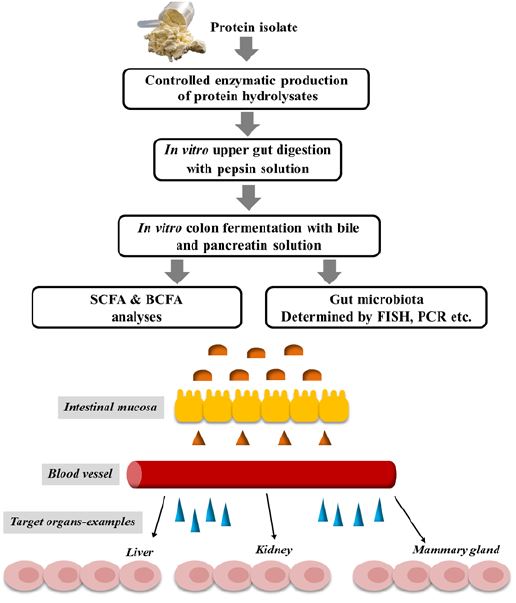Biography
Interests
Tolulope Joshua Ashaolu
College of Food Science, Southwest University, Beibei, China
*Correspondence to: Dr. Tolulope Joshua Ashaolu, College of Food Science, Southwest University, Beibei, China.
Copyright © 2019 Dr. Tolulope Joshua Ashaolu. This is an open access article distributed under the Creative Commons Attribution License, which permits unrestricted use, distribution, and reproduction in any medium, provided the original work is properly cited.
Introduction
The human gastrointestinal microbiota play important roles in human health. They are relevant in immune response and nutrition to the extent that an interruption by indiscriminate use of antibiotics or poor digestion and absorption of ingested foods may pose health risks to an individual. Therefore, essential dietary food components such as carbohydrates, fats and proteins require proper processing for fastidious physiological functions. The vast amount of proteins consumed per day necessitates a closer look at their physiological impacts on the digestive tract. Hydrolyzed proteins are easily absorbed and proffer better functionalities than native proteins, which are mostly exhibiting their primary structural conformations.
The Gut Microbiota and Its Functions
The mammalian/human gut is divided into the upper and lower parts, made of four distinct layers: serosa
(thin and encased in the mesotelium), muscle (housed within the circular and longitudinal fibers), submucosa
(rich lymphatic and blood vasculated tissue) and mucosa (the primary surface of the intestinal gut) [1].
There are more than 1014 bacterial cells/gram of luminal content of thousands of taxa in the human gut
and are regarded as the gut microbiota. They interfere with the physiological, nutritional and health status
of the host, immunomodulation of the host’s mucosa, luminal metabolism of undigested/partially digested
alimentary compounds, micronutrients, vitamin synthesis, and resistance [2].
The gut is important in the exchange of nutrients and molecules within the body. Swifter transport and absorption of foods occur here with toxic components removed. A set of hormones and neurons aid the digestive process of ingested foods, of which cholecystokinin (CCK) is considered a major gut regulatory peptide/hormone. Upon release, CCK inhibits food intake, stimulates insulin production, stomach acid secretion, and the release of bile and pancreatic juice into the small intestine [1]. Other than the CCK, the colonic microorganisms play crucial roles in the modulation of the gut as well as digestion and absorption of foods ingested. They can digest indigestible food components and provide micronutrients to the host as they reduce toxic levels and maintain healthy life. Lactobacilli and bifidobacteria are among the colonic bacterial populations shown to confer immunomodulatory functions, produce digestive enzymes and restore normalcy to the gut microbiome after antibiotic therapy [3]. Complex interactions of many microbial species in the gut lead to anaerobic breaking down of fibrous carbohydrates, proteins and peptides in a process often referred to colonic fermentation. The end products of this process include short chain fatty acids (lactate, acetate, propionate and butyrate), gases (methane, carbon dioxide and hydrogen) and branched chain fatty acids (isovalerate and isobutyrate) mostly obtained from protein and amino acids degradation. These short and branched fatty acids have their numerous benefits including neurotransmission, providing energy for colonocytes, anti-inflammation and anti-cancer functions. Modulation of gut microbiota usually results from unabsorbed sugars, resistant starch and fibers, but non-digestible proteins and bioactive peptides have been proven beneficial too [2].
Protein Hydrolysates and the Gut
Protein is a major nutrient among various food components ingested. About 120 grams of protein is daily
ingested and hydrolyzed into peptides during gastrointestinal digestion [4]. Thus, bioactive peptides or protein
hydrolysates are produced in this way. Non-gastrointestinal means of producing peptides are encouraged
to aid faster digestion and absorption, as such as hydrolyzed soy formulas included in children foods.
In the same vein, immunomodulatory and other biological activities of enzymatically prepared protein hydrolysates
have been investigated with profound outcomes [5,6], as well as their impact on mammalian gut
gene expression and microbial balance indices [7,1]. It is no news that high sulfur, eggs, fats and protein
diets increase pathogenic microbial populations and their metabolites in the large intestine [8], but their
hydrolysates portend beneficial potentials.
Nevertheless, protein hydrolysates from fish, whey, casein, scallop, crab, soy, peanut and several other plant and animal sources are reported to exhibit multifarious physiological functions including immunomodulatory activity [9,10], mammalian intestinal gene regulation [7], hypolipidemic and hypocholesterolemic properties [11], anti-inflammatory and antioxidant activity [12], anti-allergic effect [13,14] and insulin resistance [15]. All functions reported are not separable from the gut, and are mostly due to the native protein primary structure modification into secondary or tertiary structures of its hydrolysates, leading to an increased rate of absorption in the small intestine. Yet not all the hydrolysates are absorbable. Ashaolu and colleagues [2], investigated the effects of unabsorbed soy protein hydrolysates in vitro using pH-controlled batch fermentation vessels, and found out that the protein hydrolysates positively modulated the gut microbiota. The typical gut fermentation experimental flow is shown in Fig 1.

Absorption of Protein Hydrolysates via the Gut
It is acceptable to use human colon carcinoma cell line (Caco-2) as mimic absorption model for food
components in the gut due to its cost-effectiveness and ease of use [16]. Among the absorptive pathways,
peptide transported 1 (PepT1) - mediation is involved in transporting bioactive di- and tripeptides while
paracellular pathway transports shorter and hydrophilic peptides [17]. Smaller peptides from egg proteins
such LKP, YAEER, and YPI resist degradation by enterocytic peptidases while others (e.g. IQW, IRW, and
RVPSL) are easily degraded. As represented in Fig. 1, Residual unabsorbed protein hydrolysates pass to the
colon to be further metabolized by the colonic bacteria, with the end products taken up by the intestinal
mucosa, and passed through blood vessels to reach the respective target organs.
Conclusion
Several in vitro and animal models have presented tenacious evidence that protein hydrolysates have
influences on intestinal microbiome, but more in-depth investigations are required regarding clinical trials
and the stepwise transport mechanisms of these hydrolysates in the human circulatory system.
Bibliography

Hi!
We're here to answer your questions!
Send us a message via Whatsapp, and we'll reply the moment we're available!